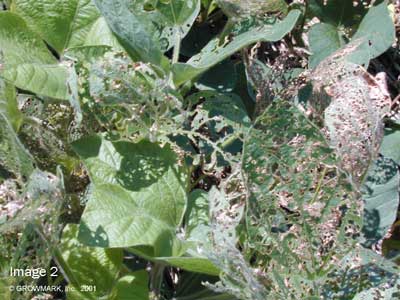
We are at the end of July and looking towards August. Soybeans are in full swing of the first three reproductive stages.
R1- Beginning Bloom
R2- Full Flowering
R3- Beginning Pod Development
The three main things I keep an eye out for as we go through these stages are insects, fungal diseases, and sudden death. In this article, we will be talking about insects. The three, depending on your area, are Japanese beetles, soybean aphids, and (with the dry weather we have experienced) spider mites. The only good thing I can say about the Japanese beetle is they are not hard to find in a field if they are present, compared to the aphids and spider mites. With a larger body and shiny green and bronze wings, they can make their presence known both with their appetite to feed on foliage and the impact they make as they land on you. Adults will emerge from grubs in July and feed on corn silks, leaves, and soybean foliage. Economic threshold for an insecticide application would be defoliation during flowering and pod development range of 15 percent to 20 percent of the soybean plant.
Soybean Aphids like cooler temperatures (highs in the 70s and 80s) for reproduction. They have the capability of doubling the population in your fields in two days and producing 18 generations in a soybean season. Overwintering on buckthorn trees starts the migration from the north working south if temperatures allow. The recommendation for treatment would be 250 aphids per plant with an average covering 80 percent of the field. I suggest that keeping an eye on the weather forecast while scouting is important when determining if treatment is necessary. If the field is nearing the threshold and the forecast continues with ideal conditions of cooler temps, treatment may be warrantied sooner than later.
With the weather conditions providing hot and dry conditions, spider mites may flair up in our soybean fields. Spider Mites overwinter as adults in grass covered areas, feeding on the grass until spring crops are growing. After laying eggs in early spring, they do little feeding during the first larval stage. When temperatures increase in the 90s, spider mite populations increase very rapid with females producing 50 to 100 eggs in their lifetime of 20 to 30 days. Universities suggest treatment is warranted by identifying the spider mites using a white paper plate and shaking the plants leaves over the top to identify the spider mites. If 20 percent to 50 percent of the leaves are discolored before pod set, treatment is recommended. The most consistent treatment is using an organophosphate that has good knock down, but will not carry a long residual.
Remember August makes a bean crop, so keep an eye out and don't let insects rob from your crop of soybeans this year.
Jason Schnell serves the FS System as GROWMARK senior field sales agronomist. He can be reached at [email protected].